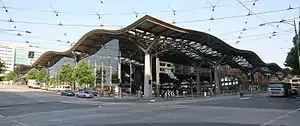Southern Cross railway station
Southern Cross railway station (until 13 December 2005 known as Spencer Street station) is a major railway station in Docklands, Melbourne. It is on Spencer Street, between Collins and La Trobe Streets, at the western edge of the Melbourne central business district. The Docklands Stadium sports arena is 500 metres north-west of the station.
The station is owned, operated and maintained by Infranexus (formerly known as AssetCo), a subsidiary of IFM Investors, under a 30-year lease to 2036 from the Victorian State Government, under a public-private partnership.[4][1]
The station is the terminus of the state's regional railway network operated by V/Line, The Overland rail service to Adelaide, and NSW TrainLink XPT services to Sydney. It is also served by suburban rail services operated by Metro Trains, being one of five stations on the City Loop, a mostly underground railway that encircles the Central Business District. It is the second busiest railway station in Melbourne's metropolitan network, with 18.614 million passenger movements recorded in 2017/18.[3] This figure excludes V/Line passengers who use the station.
Southern Cross also has a coach terminal underneath the Spencer Outlet shopping complex. Skybus Super Shuttle services to Melbourne Airport and since 2017 to Avalon Airport[5] operate from there, as well as Firefly Express and Greyhound Australia interstate coach services, a coach ran public bus (684) and V/Line coach services to Mildura, Yarram, Mansfield, and other parts of Victoria not served by rail.
History


Opened as Spencer Street Station in 1859,[6] five years after the other major Melbourne rail terminus at Flinders Street, the station was a dead-end terminus, running parallel to Spencer Street,[7][8] composed of a single main platform with a dock platform at the north end.[9] It was not until 1874 that an extra platform was provided.[9]
The two major city stations were not linked until 1879, when a single-track ground-level line was opened. It operated only at night, and only for freight trains. In the 1880s, it was proposed that Spencer Street station be removed in order to facilitate the westward expansion of the city, but the plan was subsequently rejected.
1880s: Passenger services commence
The 1880s saw the first of several grand but unrealised plans for the station. The first accepted design, drafted by Albert Charles Cook in 1883, was a fanciful Palladian palazzo design of two and three storeys, with a central portico.[10]
From 1888 to 1894, the layout of the platforms was altered, with new country platforms being built on an angle to Spencer Street itself. The current coach terminal location was the site of a number of new platforms built for suburban services.[7]
In 1891, further plans were made for a significant new station complex, including three-storey office complex and dominant clock tower, reminiscent of the later Sydney Central station,[11] but the 1890s Depression put an end to such expensive schemes.
In 1888, work started on the double track Flinders Street Viaduct linking the station to Flinders Street station. The line was initially only used by freight trains, with passenger train operations commencing in 1894.[12] It was at that time that the first through platform was provided at the station, used by suburban trains from Essendon and Williamstown.[9] The viaduct to Flinders Street was expanded to four tracks in 1915,[12] and, in conjunction with the electrification works on the suburban network, today's platforms 11 to 14 were opened between 1918 and 1924, along with a pedestrian subway providing access to them.[9]
In 1938, it was announced that construction of an improved station entrance and new car park had been approved, designed by architects Messrs Stephenson and Meldrum, costing £2,000.[13] Once again however, no construction took place.
1960s: Modernisation
In October 1960, work on a new Spencer Street station commenced, sparked by the construction of the interstate standard gauge line to Sydney.[9] A station building was constructed which largely replaced the 1880s iron sheds, and a new 413-metre (1,355 ft) platform number 1 was built. The passenger subway which had been constructed as part of the 1918 works was extended to include access to country platforms.[9] In connection with the construction of the underground loop, platforms 9 and 10 were rebuilt as part of the suburban section of the station, and a new double-track viaduct was constructed between Spencer Street and Flinders Street station, alongside the original one, bringing to six the number of tracks connecting the two stations. At the same time, the four older tracks were resignalled for bi-directional operation.
In 1962, a separate subway network was constructed to carry mail between the station and what was then the Melbourne General Post Office and main postal sorting office, situated on the other side of Spencer Street.[14]
The mechanically interlocked signal box at the station opened in 1887,[15] and was decommissioned in June 2008. Originally built with 120 levers, it had 191 when it closed, making it the world's largest.[16]
2000s: Redevelopment
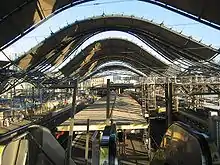
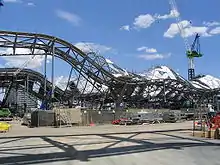

Southern Cross was redeveloped by the Civic Nexus consortium, following an innovative design by Grimshaw Architects and Jackson Architecture which features an undulating roof.[17] Construction began in October 2002 and was completed in late 2006, with the majority of the transport facilities finished in time for the 2006 Commonwealth Games. The central features of the design include a wave-shaped roof, a new entrance and concourse on Collins Street, a new coach interchange, a new food court, a bar/restaurant, separate retail outlets inside the station and a separate shopping complex between Bourke and La Trobe Streets.
This new shopping complex originally comprised a Direct Factory Outlets centre, a Virgin Megastore, along with food courts. This opened on 30 November 2006, although not all tenancies were occupied, and stage 2 was opened in March 2007. In 2009 the DFO relocated to a new site at South Wharf, the shopping centre being refitted by owner Austexx and rebranded simply as "Spencer Street fashion station".[18] In 2013 the shopping complex was rebranded as "Spencer Outlet Centre".
In addition to the physical modifications, the station was renamed from Spencer Street to Southern Cross on 13 December 2005.[19]
By July 2004, the project had fallen behind schedule and over budget by $200 million.[20] This was covered extensively in the media. As a result of over-runs and design issues, some elements of the original design, including an additional proposed footbridge connecting Lonsdale Street with Docklands Stadium, were scrapped.[21]
Complaints about access to platforms, empty trains occupying space during the day and lack of government support were raised by Leighton Contractors, the construction firm overseeing the project. This led to concerns that the station might not be ready in time for the Commonwealth Games, and the government arranged with the railway operators to provide more access to the work site.
The station's redevelopment is part of the wider Melbourne Docklands development. The architect responsible for the design is Nicholas Grimshaw. The structural engineering design was performed by WSP Global. The station has been awarded the Royal Institute of British Architects' Lubetkin Prize for most outstanding building outside the European Union.[22] The other buildings nominated were the Des Moines Public Library and the Hearst Tower, New York City.[23]
The redevelopment has meant that passengers take more time to get to the suburban network platforms than before. The pedestrian subway access was removed in favour of street level and elevated concourses. The subway also continued underneath Spencer Street, and its closure means it is necessary for all pedestrians to wait for traffic lights to cross Spencer Street at street level. For all suburban and some country services, passengers using the main entrance on the corner of Collins and Spencer Streets have to ascend two escalators to a shopping concourse and then enter the paid area of the station, before descending again to the metropolitan platforms. There have been some accidents in which people have fallen from this elevated level.[24][25] The eight-meter ascent and descent is more than necessary to clear the height of trains, and more than the three-meter descent and ascent of the previous subway.
Local architects have cited some of the Southern Cross Station's shortcomings: the building's poor connection to the surrounding streets; its awkward juncture at the pedestrian bridge that links Spencer Street to Docklands Stadium; and the baffling manner in which the grand architectural gesture of Southern Cross Station tapers off into an uninspired homage to the boxy 1980s shopping mall — Spencer Outlet Centre, which houses department store Harris Scarfe along with Witchery, Cotton On, Starbucks and many more outlets.[26]
2010s: Additional platforms
As part of the Regional Rail Link program an extra two platforms (15/16) were constructed and opened in December 2013. These are divided into 15a, 15b, 16a and 16b. They are often used for Gippsland Services, And the lines that use the RRL tracks to Sunshine (Geelong, Ballarat and Bendigo lines). These platforms allow trains to avoid the North Melbourne Flyover, which is an inconvenience for trains as it has a maximum speed of 15 km/h, and has shown to cause abnormal wheel wear on Vlocities.
Water Tower Clock
In May 2014, the historic Water Tower Clock was installed in the concourse of the station.[27] The clock had originally been erected in 1882 at Flinders Street station, opposite the end of Elizabeth Street, atop a lattice tower about 60 feet (18 m) high. In 1902 the clock was moved to Princes Bridge station, and in 1910 it was relocated again, to Spencer Street station, where it remained until it was removed as part of the station's redevelopment in the mid-1960s. The clock mechanism was given to Museum Victoria, but the characteristic turret that housed the clock was sold to a scrap metal merchant. It was later rescued by private collectors, and the clock was returned to public ownership, being put on display in 1999 at the Scienceworks Museum, Spotswood. The clock was extensively restored before its return to Southern Cross, but the original mechanism remains in the collection of Museum Victoria.[28][29]
Platforms and services

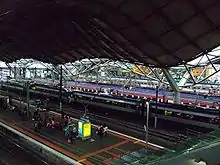
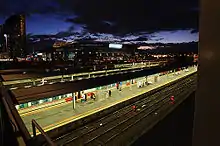
Platforms are numbered from east to west.
Concourses

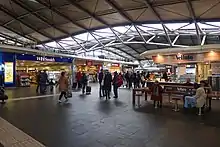
Concourses are provided at Bourke and Collins Streets. Platform 1 is north of Bourke Street, while Platform 8 South is south of Collins Street. The remainder of platforms are located between Bourke and Collins Streets, with access from both concourses, with regional services from platforms 1 to 8, and suburban services from platforms 9 to 16 (platform 8 can also accommodate suburban services if necessary).
Platforms


Platforms 2 to 7, as well as platforms 15 and 16 are numbered as two sections: section A from the Collins Street concourse to the Bourke Street Footbridge, and section B beyond the Bourke Street Footbridge. These sections were previously known as the "Central" (2C to 8C) and "North" (2N to 8N) platforms, respectively. Platform 8 has these two sections and also a "South" section (8S) underneath Collins Street used commonly for Seymour services.
Platforms 1 and 2 are fitted with dual gauge track, permitting both standard gauge interstate trains and V/Line broad gauge trains. The remainder of the platforms are solely broad gauge. A motorail dock is located at the northern end of the platform, with standard gauge access only.
Standard gauge
Platforms 1 & 2:
- Albury line V/Line services to Albury (3 per day)
- NSW TrainLink Southern NSW TrainLink XPT services to Sydney (2 per day)
- The Overland Journey Beyond services to Adelaide (2 per week)
Broad gauge
Platforms 1–7:
- Ballarat line V/Line services to Ballarat
- Ararat line V/Line services to Ararat
- Maryborough line V/Line services to Maryborough
- Bendigo line V/Line services to Bendigo, Epsom and Eaglehawk
- Echuca line V/Line services to Echuca
- Swan Hill line V/Line services to Swan Hill
- Geelong line V/Line services to Wyndham Vale, Geelong & Waurn Ponds
- Warrnambool line V/Line services to Warrnambool
- Seymour line V/Line services to Seymour
- Shepparton line V/Line services to Shepparton
Platform 8:
- Broad gauge V/Line services departing Platforms 1-7 also depart from Platform 8
- Gippsland line V/Line services to Traralgon & Bairnsdale
- Flemington Racecourse line express services to Showgrounds and/or Flemington Racecourse (special event days only)
Platform 9:
Destinations via City Loop – Clifton Hill Group:
- Hurstbridge line all stations and limited stop services to Hurstbridge
- Mernda line all stations and limited stop services to Mernda
Platform 10:
Destinations via City Loop – Burnley Group:
- Belgrave line all stations and limited stop services to Belgrave
- Lilydale line all stations and limited stop services to Lilydale
- Glen Waverley line all stations and limited stop services to Glen Waverley
- Alamein line weekday all stations and limited stop services to Alamein
Platform 11:
Destinations via City Loop – Northern Group:
- Craigieburn line all stations and limited stop services to Craigieburn
- Upfield line all stations and limited stop services to Upfield
- Sunbury line all stations and limited stop services to Watergardens & Sunbury
Platform 12:
Destinations via Flinders Street – Caulfield Group:
- Pakenham line express services to Pakenham
- Cranbourne line express services to Cranbourne
Platform 13:
Destinations via Flinders Street:
- Werribee line services to Flinders Street (trains run through to the Frankston line)
- Williamstown line services to Flinders Street (trains run through to the Frankston line)
- Flemington Racecourse line services to Flinders Street (special event days only)
Platform 14:
Destinations via North Melbourne:
- Werribee line all stations and limited stop services to Laverton & Werribee
- Williamstown line all stations services to Williamstown
- Flemington Racecourse line express services to Showgrounds and/or Flemington Racecourse (special event days only)
Platforms 15 & 16:
- Broad gauge V/Line services departing Platforms 1-8 also depart from Platforms 15 & 16.
Metropolitan transport links

McKenzie's Tourist Services operates one route to and from Southern Cross station:
Transdev Melbourne operate three routes via Southern Cross Coach Terminal:
- 232: Queen Victoria Market - Altona North[31]
- 235: Queen Victoria Market - Fishermens Bend[32]
- 237: Queen Victoria Market - Fishermens Bend[33]
Yarra Trams operate nine services via Southern Cross Station:
From Collins Street:
- 11: West Preston - Victoria Harbour[34]
- 48: North Balwyn - Victoria Harbour[35]
- 109: Box Hill - Port Melbourne[36]
- 12: Victoria Gardens - St Kilda[37]
From Harbour Esplanade:
From Bourke St:
Regional transport links
The following coach services are operated to and from Southern Cross station by private companies on behalf of V/Line:[43]
- Mildura via Ballarat, Maryborough and Donald
- Mount Gambier via Ballarat, Hamilton and Casterton
- Barham via Heathcote
- Barmah via Heathcote and Shepparton
- Deniliquin via Heathcote, Rochester, Echuca and Moama
- Mansfield via Lilydale and Yarra Glen (services extend to Mount Buller during snow season)
- Cowes via Dandenong and Koo Wee Rup
- Inverloch via Dandenong and Koo Wee Rup
- Yarram via Dandenong, Koo Wee Rup and Leongatha
- Eildon via Lilydale and Healesville, Victoria (Route 684)
References
- "About Us". AssetCo. Retrieved 28 September 2018.
- "Train Station Patronage FY2008-2014" (XLS). Public Transport Victoria. 14 May 2015. Archived from the original on 30 March 2016. Retrieved 1 November 2016. (access from "Archived copy". Archived from the original on 3 November 2016. Retrieved 1 November 2016.CS1 maint: archived copy as title (link))
- "Station Patronage Data 2013-2018". Philip Mallis. Transport for Victoria. Retrieved 4 November 2019.
- "Southern Cross Station". Retrieved 4 October 2016.
- Geelong-Avalon Airport shuttle bus service replaced by SkyBus Geelong Advertiser 9 July 2017
- Infrastructure – Southern Cross Vicsig
- Vance Findlay (August 2003). "More on Batman's Hill Station". Newsrail: 238–240.
- "MELBOURNE AND WILLIAMSTOWN RAILWAY". The Argus (Melbourne) (3, 924). Victoria, Australia. 8 January 1859. p. 5. Retrieved 2 March 2017 – via National Library of Australia.
- Sid Brown (November 2002). "Batman's Hill to Southern Cross – via Spencer Street". Newsrail: 335–347.
- Accepted Designs for the New Railway Stations, Melbourne. State Library of Victoria
- Official Design for New Station at Spencer Street
- Department of Infrastructure: Early history of Southern Cross Station Archived 4 June 2009 at the Library of Congress Web Archives
- "Spencer Street Improved Station £2,000 Plan Adopted". The Argus. 5 February 1938. Retrieved 31 May 2013.
- "Spencer Street Subway". Walking Melbourne. Retrieved 9 November 2012.
- Edmonds, Mike (20 July 2007). "Signal box concerns". Herald Sun. News. Retrieved 7 June 2008.
- "The World's Largest Signalbox" The Railway Magazine issue 1341 January 2013 page 33
- The roof transporting us to tomorrow The Age 25 March 2005]
- Marc Pallisco (3 October 2009). "DFO South Wharf, Melbourne to Open October 15". realestatesource.com.au. Retrieved 10 May 2010.
- Time's up at last for railway landmark The Age 14 December 2005
- Auditor-General’s Report on the Annual Financial Report of the State of Victoria, 2005–06 Archived 2 March 2007 at the Wayback Machine
- All change at Spencer St The Age 9 July 2005]
- "Southern Cross Station in Melbourne Wins Prestigious International Architecture Award". 22 June 2007. Archived from the original on 8 June 2011. Retrieved 23 December 2009.
- "Revamped Melbourne station wins international award". ABC News Online. 23 June 2007. Retrieved 23 June 2007.
- "Man critical after horror fall from escalator at Southern Cross". The Age. Melbourne. 14 July 2010. Retrieved 12 April 2011.
- "Woman badly hurt in station fall". The Age. Melbourne. 25 June 2010. Retrieved 12 April 2011.
- "Station's curves prove real head-turner". The Age. Melbourne. 14 July 2007.
- "Melbourne's 130-year-old Water Tower Clock back at Southern Cross station". Melbourne Leader. 15 May 2014. Retrieved 2 March 2015.
- "Old clock's time to shine". Museum Victoria. Retrieved 2 March 2015.
- "Water Tower clock installed at Southern Cross Station" Railway Digest July 2014 page 23
- "684 Eildon - Melbourne via Lilydale Station". Public Transport Victoria.
- "232 Altona North - City (Queen Victoria Market)". Public Transport Victoria.
- "235 City - Fishermans Bend via Williamstown Road". Public Transport Victoria.
- "237 City - Fishermans Bend via Lorimer Street". Public Transport Victoria.
- "11 West Preston - Victoria Harbour Docklands". Public Transport Victoria.
- "48 North Balwyn - Victoria Harbour Docklands". Public Transport Victoria.
- "109 Box Hill - Port Melbourne". Public Transport Victoria.
- "12 Victoria Gardens - St Kilda". Public Transport Victoria.
- "35 City Circle (Free Tourist Tram)". Public Transport Victoria.
- "70 Waterfront City Docklands - Wattle Park". Public Transport Victoria.
- "75 Etihad Stadium Docklands - Vermont South". Public Transport Victoria.
- "86 Bundoora RMIT - Waterfront City Docklands". Public Transport Victoria.
- "96 East Brunswick - St Kilda Beach". Public Transport Victoria.
- "Timetable list". V/Line - Regional public transport for Victoria. Retrieved 18 March 2018.
External links
| Wikimedia Commons has media related to Southern Cross Station. |
- Southern Cross Station
- Southern Cross Station project at the Library of Congress Web Archives (archived 2009-05-30)
- Railpage Southern Cross Platform allocation discussions
- Southern Cross Station subway re-opening discussions
- Diagram of the track layout at Southern Cross station
- Construction images: 2003 – 2004 and 2005 – 2008
- Melway map at street-directory.com.au
